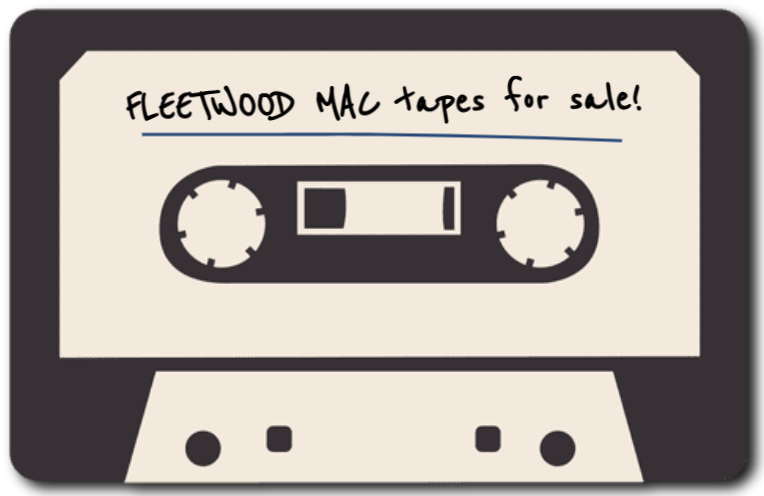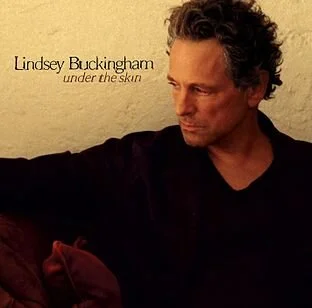Lindsey Buckingham “Under the Skin”
Lindsey Buckingham’s fourth solo album opens mid dream interpretation in a therapy session. Beneath his trademark finger-picking is a hushed diary confessional in which the singer reads a newspaper article about a visionary no one knows about. Then, in that same quiet voice, he admits to the problem of feeling unseen. It’s a great irony, of course, to complain about, considering just how “seen” this musician has been. In Fleetwood Mac, he stood alongside Stevie, in front of the most commercially successful band of their day. But where his bandmate and one-time romantic partner conjured her great solo career with a witchy twist of the wrist, Buckingham had more trouble. There was something pent up in him — something trapped. What was it?
His first two solo albums have a kind of “Look at me! I’m interesting!” quality that can feel forced. They’re soaked in lots of double-triple-quadruple, tracked vocals, using technology to turn himself into his own angular version of the Beach Boys. It’s tinkered, tricky music. But like other studio wunderkinds, the BB of “ABBA”, or Jeff Lynne of ELO, there is a certain ecstasy in these perfect-to-the-millisecond arrangements. But unlike those artists, Buckingham has a real tilt toward the avant-garde.. He’s got a little Yoko Ono hiding out in him and it can produce interesting and varied results. There’s the oddball title track of Fleetwood Mac’s “Tusk” and less interesting ones, like “Bwana” from his first solo album “Law and Order,” which features a kazoo and lands near the dark side of the cutting edge.
Buckingham is a lanky, twitchy figure in his 80s solo videos, extremely handsome but also odd — like Rick Ocasek in the body of Bradley Cooper. How honest his instinct for the avant-garde is, I don’t really know. We tend to love and hate these masters of melody. Do they internalize this and struggle inside? Does it cause the tremors of “I’m not Barry Gibb! Watch me shred!”? Fortunately, by 2006 ,Buckingham had mellowed, and not in a boring way. There’s a reason his 1983 single “Holiday Road” was used as the theme of National Lampoon’s Vacation, a movie about a family trying to have a fun but going insane. Buckingham’s work can be a bit hyperactive. When it’s in check, it’s invigorating. Out of check, it’s disorienting, even maddening. That lightning quick finger-picking is a strength and weakness. He wants to go forward, fast and be at the front. But where does he want to go and who does he want to be?
Buckingham talked openly about the musical push forward he was attempting with Fleetwood Mac, after “Rumors” became the album heard round the world, and they had a blank check for the follow-up. That album, “Tusk”, made in the wake of punk, has a really astonishing combination of styles coming from the three distinctly different songwriting styles of Nicks, McVie and Buckingham. Like The Beatles “White Album”, “Tusk” finds the band collaborating less on individual songs, but balancing each other through alternation. Buckingham’s contributions find him turning the band toward the art-rock of the Talking Heads with more golden harmonies. McVie’s songs provide a mellow, easily melodic counterpoint, and Nicks has her own mysterious ability to take personal longings and spread them to a universal emotional canvas. When it all works, as I’d argue “Tusk” does, you feel like you’ve just been through a long, multilayered journey. Sales told another story. “Tusk’s” lackluster reception put the end to Lindsey using Fleetwood Mac as a way to become the next great stylistic innovator. His envelope pushing instinct was relegated to his solo albums.
Despite some expensive music videos, and a photo shoot casting him as a glamorous classic Douglas Fairbanks type, no one showed up to the solo career. Maybe letting go of that kind of blockbuster objective helped “Under the Skin,” which seems his most coherent and confident statement of “This is who I am, take it or leave it”. “Under the Skin”, like all the solo work, is Buckingham (mostly) alone in the studio, but the recording flourishes are reined in. It’s a lot of quietly tinkered acoustic-based music. If he was using 20 tricks to concoct his tunes in 1981, he’s down to 4. His writing is more confessional, reaching out to you more than it seeks to impress, and he’s no longer preoccupied with making you think he’s edgy or that he can rock. The balance he found in Fleetwood Mac — Stevie rolling her eyes to shut down his masturbatory guitar sqwonking — he has finally found within himself.
The second track and non-charting single “Show You How” surges with an infectious patted out hand on synth kneecap drum beat. It works successfully in miniature, orchestrating a small choir of Buckingham vocals on the chorus, but keeping the versus extremely spare. It’s a model of balance, and makes his early solo work seem all the more overworked. When he goes bigger, it’s proportional. The penultimate track, “Someone’s Gotta Change Your Mind” adds a horn section to the spare production. opening up that hushed sound to something more anthemic. It should have been a hit somewhere, maybe he just got pigeon-holed out of airplay. If you put a big beard on him, he’s taking bows at Coachella.
Even the two covers on “Under the Skin” feel vital. The Rolling Stones’, “I am Waiting,” comes across as a fittingly personal tale of waiting for a muse, the hopelessness that she may not return, and the beauty of her arrival. Donovan’s “Try for the Sun” fits in alongside Buckingham’s other songs of romantic ruin, replacing anger with acceptance and grace. “Shut us Down” is not a cover but resembles some unknown outtake from an Elliot Smith album. Its has the same quiet “you’re my only friend, hear my secrets” quality of Smith’s work. Maybe this rock star just needed the humbling of three unsuccessful solo albums to drop some of the tricks and write from a more open place. Re-marketed into a new indie band from Sweden, could this middle-aged artist have found an audience? Should we be happy he didn’t? Did this lack of solo success give him some struggle to write from? In the bridge to “Not Too Late” he sings “My children look away, they don’t know what to say”, averting their eyes from their own beaten-down father. It’s an easy posture to be on a record singing angry about exes. This, however, is another level of disclosure.
By album’s end, the “I’m unseen” complaint in the opener doesn’t sound so unnecessary. Lindsey Buckingham evolved into an unknown cult act, whose role in one of the biggest bands in the world had ironically worked against his coronation as an individual artist. The album ends with a song called “Flying down to Juniper”, which takes an atypical turn into a samba rhythm. Somehow, he manages to add a melody on top that makes the dance beat lugubrious. It’s one of the only missteps on the album, but one of the order he’s always been pursuing, trying new things.


